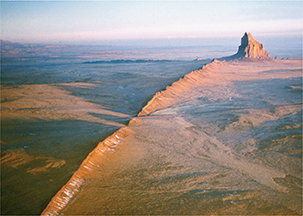Figure 43 Ship Rock in New Mexico is a volcanic neck. It formed when the soft rock around a volcano's pipe wore away, revealing hard, igneous rock. The long ridge extending from the volcanic neck is a dike.

Other Igneous Features
Sometimes magma does not reach the surface, but cools and hardens in the crust. This magma forms intrusive igneous rock that may eventually be forced upward and exposed at Earth's surface.  Igneous features formed by magma include batholiths, sills, dikes, and volcanic necks. Lava plateaus are features formed of extrusive igneous rock.
Igneous features formed by magma include batholiths, sills, dikes, and volcanic necks. Lava plateaus are features formed of extrusive igneous rock.
A batholith is the largest type of intrusive igneous rock mass. Batholiths often form the core of a mountain range, such as the Sierra Nevada range in California. Magma sometimes squeezes into a crack between layers of rock and then hardens. If the crack is parallel to existing rock layers, the magma hardens into a structure called a sill. If the crack cuts across rock layers, the hardened magma forms a dike. When magma hardens in a volcano's pipe, a structure called a volcanic neck may form, as shown in Figure 43.
The largest lava flows don't come from individual volcanoes. Rather, large amounts of easily-flowing lava sometimes erupt from a cluster of long, thin cracks in the crust. This lava may spread out over an enormous area before solidifying. After many years, layers of hardened lava may form a high, level area called a lava plateau. An example is the Columbia Plateau, which has an average thickness of more than 1 kilometer and covers an area of nearly 200,000 square kilometers in the Pacific Northwest.
Section 22.6 Assessment
Reviewing Concepts
 Describe the process that leads up to the eruption of a volcano.
Describe the process that leads up to the eruption of a volcano. How does the silica content of magma affect how explosive an eruption is?
How does the silica content of magma affect how explosive an eruption is? Explain why volcanoes form in certain regions of Earth's surface.
Explain why volcanoes form in certain regions of Earth's surface. Describe four types of intrusive igneous rock features.
Describe four types of intrusive igneous rock features.
Critical Thinking
Relating Cause and Effect What condition must exist in a volcano for a caldera to form?
Predicting What would eventually happen, as a result of plate movement, to a volcano that formed over a hot spot?
Comparing and Contrasting What is the difference between a dike and a sill?
Writing in Science
Descriptive Paragraph Use library or Internet resources to research a major volcanic eruption. Write a paragraph about the eruption including when and where it took place and the type of volcano involved.




